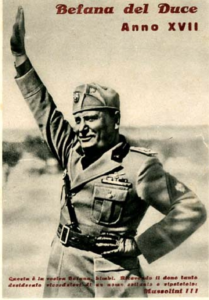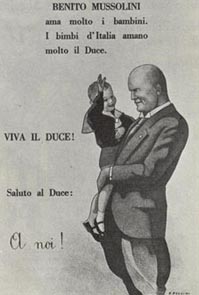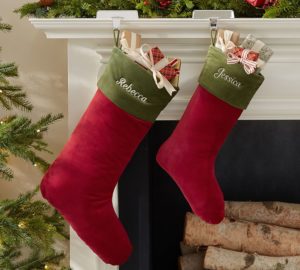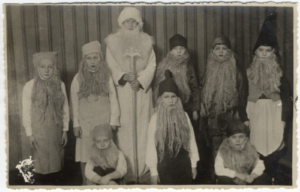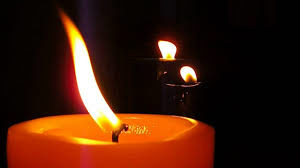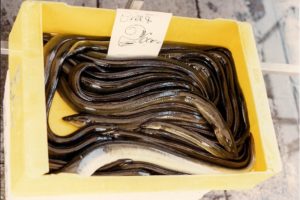Writing is not necessarily something to be ashamed of–but do it in private and wash your hands afterwards.
Befana Fascista
One of the major Italian magical Gift-Bringers is the Befana, a kindly witch who visits children on the eve of Epiphany (her name is a corruption of Epiphania). During the fascist period from 1922-45, the dictator Benito Mussolini supplanted the broom-borne crone as the provider of all good things for Italy’s little ones.
According to Quinton Hogg
Conservatives do not believe that political struggle is the most important thing in life…The simplest among them prefer fox-hunting—the wisest religion.
Christmas Stocking
Medieval legend says that St Nicholas saved three daughters of a poor man from lives of shame by dropping bags of gold into their stockings. From this came the tradition of setting out a stocking or shoe during the Christmas season for the Gift-Bringer to fill it with treats and presents. Given Santa Claus’s usual means of entry, the fireplace was the logical location to hang up one’s stocking, as can be seen in Clement Moore’s 1821 “A Visit from Saint Nicholas”:
He spoke not a word, but went straight to his work,/ And filled all the stockings; then turned with a jerk,/ And laying his finger aside of his nose,/ And giving a nod, up the chimney he rose.
However, placing a stocking by the window, at the foot of one’s bed or by the family crèche also have their supporters. For a time, after the middle of the nineteenth century, the stocking was eclipsed by the Christmas tree as the place to find one’s presents but in many families the two have long coexisted with small presents and candies being put in the stocking and larger gifts ending up under the tree.
In England and in British Commonwealth countries such as South Africa or Australia, it is customary for a pillow-case to serve as a stocking. In some areas the receptacle is called a “Santa Sack.”
Latvia, Christmas in the 1920s
Bad omens and Christmas
It is said in Sheffield, England “A candle or lamp should be left burning all night on Christmas Eve. Unless this is done there will be a death in the house”
Another Christmas superstition was that of decoration, especially in the north of England, in Northumberland. Many superstitions rose up in the area about how long to leave boughs of holly, both in the home and in the church. For many centuries the standard operating procedure was to leave them in place until 2 February (Candlemas) at the home, or else “something evil” would befall one of the senior members of the family. But in the church, practice was far more stringent, with the stipulation that were any of the festive decorations still left in the pews after Candlemas someone in the family that occupied that pew would die, and die soon to boot. Some people were so frightened of this possibility that instead of leaving the cleaning to the church authorities they would send their own servants to clean their pews.
According to Hugh Hefner
It has been our experience that women usually prefer thin, undernourished, flatchested females, dressed to the teeth, as a concept of “feminine beauty” — and that men prefer exactly the opposite: voluptuous, well-rounded and undressed. The women’s idealization of woman is actually a male counterpart, competing with man in society; man’s view of women is far more truly feminine.
According to Confucius
“If things far away don’t concern you, you’ll soon mourn things close at hand.”
IRA Christmas Cards
Despite being murderous, terrorist swine, the Irish Republican Army liked to propagandize with cards at Christmas time
Here’s a message of love and peace from 1976:
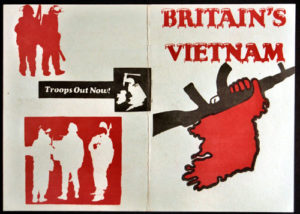
And one from 1996:
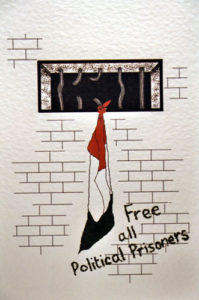
Christmas Eels
Eel is a traditional food for Christmas Eve in Venice. Grilled eels are popular and it is said that the Doge Andrea Gritti died at the age of 84 on December 28, 1538 after eating too many grilled eels on Christmas Eve.
A famous preparation for Christmas Eve on the island of Burano in the Venetian lagoon is a risi e fasjoi col brodo de gò, rice and beans with a broth made of goby. This isn’t the only famous Venetian dish with eel. Risotto de la “Visilia” is a special risotto made on Christmas Eve. It is unusual for two reasons: it is not cooked according to the risotto method, although it’s called a risotto, and it combines cheese with fish. The dish probably evolved from a simple fish pilaf, using, for example, goby. Then the eel was added and finally the beans.
The popularity of eel for Christmas in Naples, and in fact throughout Italy, seems to be a phenomenon of pre-Christian times related to a water cult of the Etruscans that has now become a ritual food in which, in the words of author Carol Field, “the sacred and profane meet.” Of course, one reason that so much Christmas food revolves around fish is because of the symbology of fish in Christological thought, namely, Christ as a fisher of men.
Thanks to http://www.cliffordawright.com/caw/food/entries/display.php/id/51/
